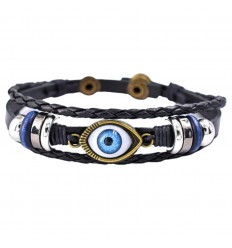In recent years, jewelry against the evil eye with a blue eye pattern has made a comeback in the world of fashion
However, this style of jewelry has existed for several hundred years in Turkey and Greece.
How to explain such a craze for this motive yet so old?
The current popularity of blue eye jewelry is explained by its primary function in Mediterranean culture.
Indeed, behind this aesthetic hides a very particular use: before being a jewel, its main vocation was to protect its wearer from the curse of the "evil eye".
.jpg)
What is the superstition of the "evil eye"?
First of all, it is good to remember what the superstition of the "evil eye" consists of.
The evil eye is a curse cast by the gaze of an envious person, in order to bring down the misadventure on the targeted person.
This belief, very present in Islam and Judaism, has many followers throughout the Mediterranean basin. The important influence of the former Ottoman Empire, in particular, helped spread the legend of the evil eye in multiple Mediterranean ports between the fourteenth and nineteenth centuries.
It is therefore quite natural that the Turkic and Greek peoples adopted protective measures to repel evil by resorting to rituals or incantations.
The most popular form of protection to deflect the curse remains the blue eye talisman, also called "Nazar Boncuk" or "Greek eye".
Its purpose is to counter the curse in a preventive way, because in most cultures, when the "evil eye" is projected, the targeted person cannot be aware of the harm that is desired to him.
Due to its design and original shape, the "Nazar Boncuk" has easily managed to establish itself as a symbol.
This talisman takes the form of an eye and would thus make it easier to repel the curse, as well as protect the property of the person who wears it.
The "Nazar Boncuk" is composed of a drop-shaped glass disc, respectively assembled from four concentric circles ranging from dark blue to black, through white and light blue.
This symbol is usually found hanging above front doors, on the walls of houses, or in cars.
If the "blue eye" breaks, then this one has fulfilled his contract, he has "repelled evil". It must then be quickly replaced or risk exposing oneself to a new curse.
.jpg)
How did the tradition of "Nazar Boncuk" adapt into jewelry?
The talisman "Nazar Boncuk" has adapted to the change of era, putting its protective role on hold to become a jewel with its style in its own right.
This is partly due to the fact that the Mediterranean peoples entered a period of prosperous peace, which allowed them to soften their way of life.
Mentalities evolved along with culture and art, throughout the Mediterranean basin, and people began to buy objects for their aesthetic side.
There is a proliferation of trade in luxury goods and objects such as silk clothing and jewellery.
This allowed a rapid development of jewelry and especially the know-how of jewelers.
This evolution took place after very long changes in customs, which gave jewelers time to rework the design.
Thus the blue eye talisman became a unique style of jewelry, appreciated by Mediterranean peoples.
The stages of the creation of the contemporary blue eye jewel
The blue eye talisman jewel first appeared in Turkey in the form of a rudimentary pendant, because it was in this region that the belief in the legend of the evil eye was strongest.
The Ottoman peoples created these pendants by wrapping fishing lines around the "Nazar Boncuk" talismans to be able to wear them around the neck, in order to protect themselves personally from the evil eye.
Seeing the popularity of this practice, Anatolian jewelers had the idea of giving the jewel a more aesthetic side, by creating pendants more worked with the motif of the eye of Nazar. It was immediately a huge success throughout the empire, so much so that Kösem, one of the most powerful women in Ottoman history, unofficial ruler of the Ottoman Empire, began to own several.
Faced with the magnitude of this phenomenon, many variants of blue eye jewelry were born, earrings, rings, bracelets and the famous blue eye necklace.
The diversification of the jewel led to a multiplication of styles. Her feminine side gradually asserted herself.
Greek women in particular, were quickly won over by the unique style of these blue eye jewels inspired by the "Nazar Boncuk", a motif already famous in their country.
The key to its popularity was its dual use as it was both perceived as an aesthetic jewel and a protective talisman.
The success of the blue eye jewel then spread to the neighboring peoples of the Ottoman Empire, thanks to its commercial and cultural influence.
These peoples were also conquered by the beauty of this new style of jewelry. This was first the case for the Muslim countries of the Maghreb, then in the Arabian Peninsula. More and more people began to wear blue eye jewelry and within a few decades, this new jewel had spread throughout the Mediterranean basin.
They were sold successfully by the Ottoman sailors, because of their religious and cultural proximity to the peoples concerned.
Blue eye jewelry was then imported to the northern Mediterranean countries thanks to Greek and Turkish commercial activities, but in these countries, they were more appreciated for their aesthetic than mystical side.
.png)
The fashion of blue eye jewelry in our time
But how did this trend cross the Mediterranean Sea to impose itself on a global scale?
In Europe, in the 60s and 70s, countries at peace will develop an intense cultural and artistic policy and we rediscover our ancient heritage. Even the cinema seizes antiquity with success (worldwide success of the films Spartacus or Ben Hur).
Western peoples began to take a closer interest in Greek art and customs. Then, influential European fashion designers began to incorporate designs inspired by ancient Greek jewelry into their collections.
This large-scale exhibition allowed blue eye jewelry to be widely democratized in the world of fashion. It will be remembered that they were the inspiration for very noticed creations during Paris Fashion Week in 2018.
The ultimate consecration of blue eye jewelry was the work of French jeweler Ariane Chaumeil who integrated it into her Spring Summer 2018 collection. In collaboration with the famous Greek fashion designer Paris Valtadoros, she was inspired by the blue eye of Crete and thus allowed this style to reach the highest spheres of the fashion world.
So we see that throughout history, the blue eye pattern first influenced the art of Mediterranean jewelry by relying on the superstition of the evil eye. Thanks to their talisman value, the jewels Blue eyes quickly spread throughout Mediterranean civilizations. Then, much more recently, and thanks to the influence of contemporary jewelers who reworked it, blue eye jewelry penetrated the world of international fashion, and gained popularity around the world.
Now that you have mastered the subject, we invite you to discover our range of jewelry related to this protective talisman!
Sources:





















.JPG)
























Comments (1)